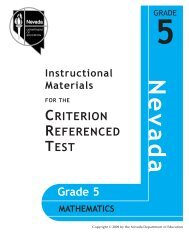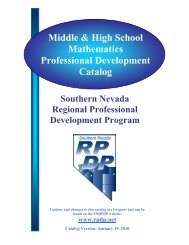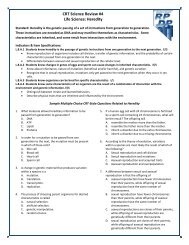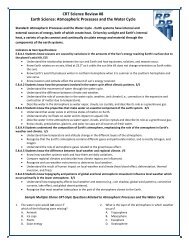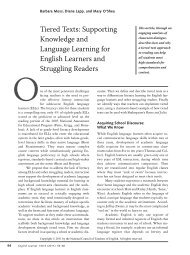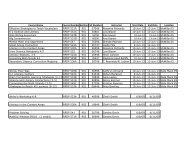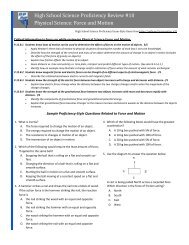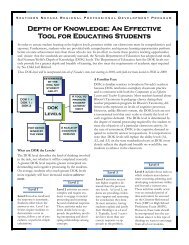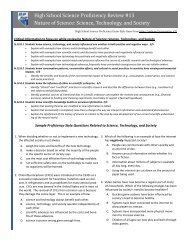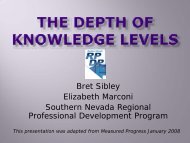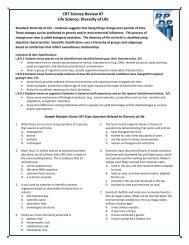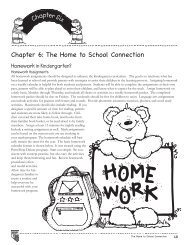Download - RPDP
Download - RPDP
Download - RPDP
Create successful ePaper yourself
Turn your PDF publications into a flip-book with our unique Google optimized e-Paper software.
Formative Assessment in<br />
Elementary Science<br />
When you hear the word “formative”<br />
assessment, does the thought of portfolio<br />
management come to mind? How about<br />
checklists that get shuffled around the top<br />
of your desk, or the backseat of your car<br />
because you just can’t figure out what to do<br />
with the information that you’ve gathered? It<br />
doesn’t have to be that way! By spending<br />
some time with your students, asking some<br />
thought-provoking questions, and listening to<br />
them talk about what they are doing in class,<br />
you can gain a very clear picture about what<br />
your students understand.<br />
Assessment “for” learning vs. assessment<br />
“of” learning - the distinction between the two<br />
is pivotal. Assessment for learning happens<br />
while learning is still underway. It isn’t about<br />
grades, but about getting better. “Effective<br />
use of formative assessment includes using<br />
assessment results to plan instruction, using<br />
assessment information and materials to<br />
involve students in their own assessment,<br />
and communicating assessment results<br />
clearly and in a way tailored to the user’s<br />
needs.” (Stiggins et al., 2004, 2006)<br />
According to Stiggins et al., the student’s role<br />
in formative assessment is to self-assess<br />
and keep track of progress, set goals, and<br />
act on assessment results. “Self-assessment<br />
by pupils, far from being a luxury, is in<br />
fact an essential component of formative<br />
assessment.” (Black & William, 1998)<br />
Something as seemingly simple as having<br />
students restate the problem or the question<br />
can lead to creativity and self-confidence.<br />
By allowing our students to talk about their<br />
solutions or their thoughts, by allowing them<br />
to talk with others, and even more powerful, if<br />
they can spend time talking with their teacher,<br />
students get immediate feedback and make<br />
connections that will in turn, facilitate future<br />
decision making.<br />
Science notebooks can be a part of ongoing<br />
formative assessment in the classroom.<br />
The writing contained in these notebooks<br />
can allow the teacher to see what students<br />
understand, how they approach problem<br />
solving, and what misconceptions they<br />
have. Before you start thinking that the use<br />
of notebooks in class means yet another<br />
thing for you to grade, they aren’t for that<br />
purpose. Formative assessment is not to<br />
be graded, but for getting better, remember?<br />
Science notebooks are more likely to be a<br />
learning tool if students feel safe to express<br />
what they know and to show how they know.<br />
When students are actively engaged in<br />
using notebooks, these notebooks have an<br />
important role in improving expository writing,<br />
vocabulary development, understanding the<br />
nature of science and math, and improving<br />
student learning and achievement. That’s a<br />
lot of bang for a small notebook.<br />
Based on brain research, teachers may be<br />
accidentally impeding thinking, intelligence<br />
and brain growth, and ultimately creating<br />
“slow learners” by the lack of feedback and<br />
the large lag time we have built into the<br />
typical learning environment. How often do<br />
classroom teachers meet with students and<br />
actually spend time talking with them? A<br />
conversation with students could be a handy<br />
proactive tool instead of being faced with<br />
re-teaching after discovering that half of the<br />
class can’t apply the math concepts needed<br />
for the constructed response.<br />
When students talk deliberately, purposefully,<br />
and perceptively, learning and thinking<br />
increase dramatically. The better the<br />
quality of the questions that we ask our<br />
students, the more their brain is challenged<br />
to think. A challenge to think should bring<br />
about disequilibrium – when we are feeling<br />
perplexed or unsure or even confused about



